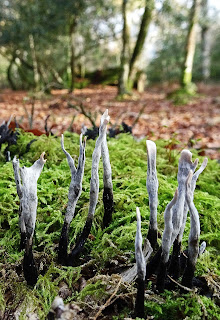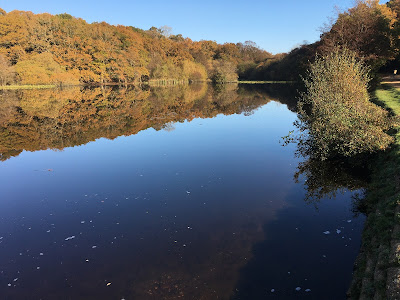P. hymenina is supposedly common
and widespread, but I had only come across it in field guides up until now.
On this same log were several other lichens (including Cladonia
digitata), lots of mosses and a single Scots pine seedling.
CR.
P. hymenina is supposedly common
and widespread, but I had only come across it in field guides up until now.
On this same log were several other lichens (including Cladonia
digitata), lots of mosses and a single Scots pine seedling.
CR.
 |
| Barnacle Geese amongst Canada and Brent Geese |
Next came a large flock of Golden Plover and 2 Ruff on Pennington Marsh, one of which was very active and doing a passable impression of a snowman/bird! All of the usual suspects were on Fishtail but the Pintail (M) get the award for the snappiest dressers. We turned back from the junction of Keyhaven and Fishtail Lagoons and continued via Butts, Jetty and Pennington Lagoons, Oxey Marsh, Salterns Marsh and 8 Acre Pond to the undoubted highlight, Normandy Marsh. Because of the state of the tide birds were crammed into the lagoons and its islands.
 |
| Ringed Plover and Dunlin |
Neither they nor us were sheltered from the sudden arrival of squally winds and heavy rain/hail/sleet but we managed to see: Avocet, Red-breasted Merganser (M+F), Goldeneye (F), Kingfisher, Dunlin, Curlew, Cormorant, Great Black-backed Gull, Ringed Plover, Grey Plover, Lapwing, Shelduck, Shoveler, Redshank, Greenshank, Oystercatcher and Snipe.
 |
| Avocet |
 |
| Seasonal pond at Nomansland Green. MW |
 |
| Sulphur Tuft (Hypholoma fasciculare) MR |
Somewhat chewed, we made a hasty exit down the path through mixed woodland, tramping in thick, leafy layers below spindly birch and large beech, now almost bare, though oak was hanging on to rich-brown leaves. The little gully we crossed was in modest flow after recent rain that had benefited the bright, feathery tufts of Hard Fern (Blechnum spicant) overhanging the bank.
 |
| Hard Fern (Blechnum spicant) MW |
Joining a wide ride we continued downhill then turned left uphill towards Bramshaw Wood carpark. Several trees have fallen here over the years in messy tangles, bearing more Sulphur Tuft and stacks of Turkey Tail (Trametes versicolor). Tiny, glistening-white clumps of Porcelain Fungus (Oudemansiella mucida) contrasted with the hard, black blobs of King Alfred’s Cakes/Cramp Balls (Daldinia concentrica). Missing our field companions, we struggled with identifying some fungi but thought they might be Mycena sp. and/or Russula sp.
Just short of the parking area we turned south-east onto the old Church Path. Heading steadily downhill, ignoring any side paths, we reached a bog, dry-ish in summer but now very wet. Apart from some clumps of black and grey Candlesnuff (Xyaria hypoxylon) on mossy mounds, the only creature of note was a large golden retriever, revelling in traipsing through the mud up to its belly, clearly on borrowed time pending the arrival of the owner.
 |
| Candlesnuff (Xyaria hypoxylon) MW |
 |
| Turkey Tail (Trametes versicolor) MR |
 |
| Cramp Balls (Daldinia concentrica) SP |
 |
| SP |
Birds were clearly otherwise engaged this morning, making brief appearances or just calling from afar. Hence, we bagged only Blackbird, Blue Tit, Carrion Crow, Common Buzzard (heard), Jackdaw, Nuthatch (heard), Robin and Woodpigeon. MW/SP/MR
On a misty morning Richard Smith, Diane and I set off from Bolderwood car park to look for winter thrushes.
We walked past the Deer Sanctuary (no deer or birds to be seen) and continued on the path downhill. It didn’t seem very promising as all we saw at first were robins, dunnocks and blackbirds but as we got further on there was movement above and around us. Long-tailed, great and blue tits, treecreeper, nuthatches and goldcrests were constantly on the move in the trees giving us good, if fleeting, views.
The shortcut that we usually take on this part of the walk was so squelchy that we stayed on the hard path until it met the cycle path at a T-junction, where we turned right to head up to the holly plantation. The birds were more obliging here with nuthatches feeding on the path and a goldcrest moving about in the bracken.
Nuthatch - RS
CR
Map:
We arranged to meet Richard Smith a couple of days early for our walk, due to the poor forecast for Thursdays weather . Meeting up at Setley Pond in early morning sunshine we immediately saw the grey heron, as Setley is known for its long standing heronry. Walking towards the A337 on first the heath and then through narrow paths we noted fresh rabbit holes, a field of crows and a pair of probably goldfinches flying swiftly away.
A not-to-be-missed opportunity to leave gloomy lockdown behind and to travel with us to sunny Central America to learn about the colourful and magical bird life of Costa Rica. Our speaker will be wildlife photographer, Steve Oakes.
As a follow up to our last, wonderfully illustrated talk, given by Jane Russ, the Secretary of the Hare Preservation Trust, you might like to follow this link to her publisher, to see her wildlife series of books, including 'The Hare'. https://graffeg.com/collections/nature
At this time of year many of us have been looking for
fungi in the Forest. One that you may have overlooked is Claviceps purpurea,
Ergot of Rye.
Easily missed, this is one of the most significant fungi
in the history of mankind. It belongs to the fungal group called Ascomycetes
and affects the ovaries of many grass species, but it is especially important
in the Rye grass species. The ‘Ergot’ (from the old French argot, a
cockspur) is the overwintering structure of the fungus. It contains a cocktail
of alkaloids that cause harm and death to animals, including us.
During the Middle Ages ergot may have poisoned at least
10% of the population of western Europe, due to the use of rye in bread
production. Until 1670 it was not understood that ergot was the cause of severe
illness when ingested.
The effects of eating ergot in bread depend on the concentration of the alkaloids, but convulsions, spontaneous abortions and gangrene are the most obvious. It causes the peripheral blood vessels to contract, cutting off the blood supply to the extremities and to the womb, hence the miscarriages. It also contains hallucinogens making sufferers incoherent. It was commonly known as St. Anthony’s Fire as the sufferers were treated in hospitals dedicated to St. Anthony, usually until they died. Some outbreaks in the 1800s are reported to have had mortality rates of up to 40%.
Nowadays there are ways of separating the ergots from the rye seed and there are many pharmaceutical uses for the alkaloids, but I wouldn’t recommend eating any that you find!CR
 |
| Eyeworth Pond |
 |
| Schultze Gunpowder Factory - then and now |
Little is left of the factory that at one time employed over 100 people and was the world’s largest supplier of sporting gunpowder. Some of the remaining buildings can still be seen and are believed to be stabling for 40 horses and accommodation. Additionally, the gravel track from where the walk sets off, is known as Powder Mill Road, providing a route for explosives to be taken by horse and cart up onto the Cadnam road (3).
 |
| Powder Mill Road |
Setting off on a bright calm morning, the pond was mirror calm, disturbed only by numerous pairs of Mallard, a few Moorhen, and a single Little Grebe. Immediately beside the car park, is a favourite spot for photographers who bait the surrounding posts and attract large numbers of woodland birds. Today was no exception and there were frequent visits by Blue Tit, Great Tit, Marsh Tit, Nuthatch, Robin and Chaffinch. Walking just a few yards north along the track, brings you to the site of the Irons Well or Chalybeate, marked on the OS. Here, a spring rises, rich in iron salts giving the ground a rusty brown appearance. The waters were thought to be a cure for leprosy and later, for curing mange in dogs and at one time there was a hatch where people could drop their unfortunate dogs into the healing waters! Nowadays the spring is simply an enclosed square close by the path.
Walking further along the track a Great Spotted Woodpecker called in the trees lining the path but evaded attention. Crossing over the valley and fording the small brook, that feeds Eyeworth pond, there is a short climb up onto the ridge above the valley where a fairly extensive stand of Holly trees is found. These were attended by Blackbird, Song Thrush and a small contingent of Redwing that proved flighty and difficult to photograph, but eventually patience was rewarded!
 |
| Edge of Eyeworth Wood |
Crossing the bridleway you reach the old earth embankments that define Studley Wood, a mixture of predominantly beech and some oak trees looking lovely in the Autumn sunshine. Little is left of Studley Castle, the old Hunting Lodge, aside from some slightly raised earthen banks, but it is a tranquil part of this forest. Walking back down the firebreak towards Eyeworth I heard a tremendous clattering of antlers in the woods and paused to watch, from a respectful distance, two Fallow Buck battering at each other, whilst the does looked on with little interest! Very few fungi were seen aside from some Candle Snuff fungi (Xylaria hypoxylon) on a log. A treecreeper explored an Oak tree, buzzard called overhead and Goldcrest flitted through the holly bushes but again, but all evaded photography!
 |
| Candle Snuff Fungus |
 |
| Mandarin Duck |
Returning to the pond, just above the sluice gate at the southern tip, I watched a Kingfisher hover briefly and dive before speeding off with its catch. Several pairs of Mandarin Duck, for which Eyeworth is known, eventually emerged from the edge of the pond and showed off in the sunshine. Finally, as I returned to the car, I was delighted to see Robert and Glynis, and again reminded of the pleasure of walking with a group of experts - one day, somehow, we will get back to that! Until then I post a route map and GPX file that can be downloaded by those wishing to follow the route.
References
1/ https://newforestguide.uk/history/new-forest-explosives/schultze-gunpowder-factory/
2/ http://newforestcommoner.co.uk/2015/06/01/new-forest-chalybeate-springs-and-aquatic-things/
3/ http://www.newforestexplorersguide.co.uk/heritage/history-in-the-landscape/eyeworth-pond.html
Map / GPX

 |
| Turkey Tail |